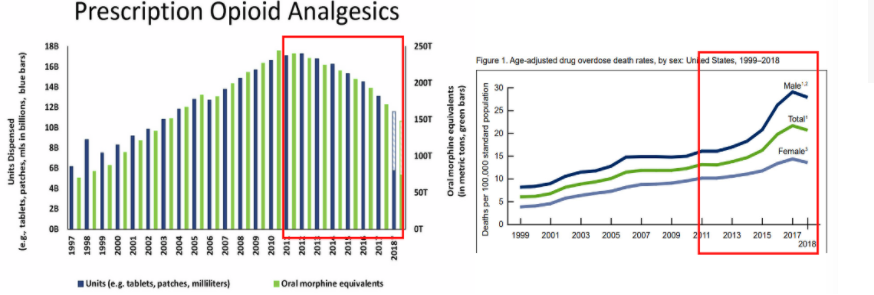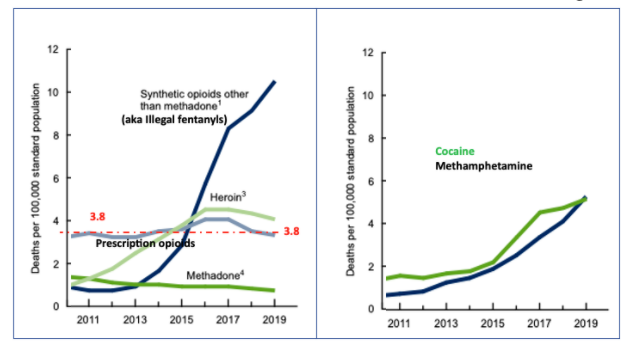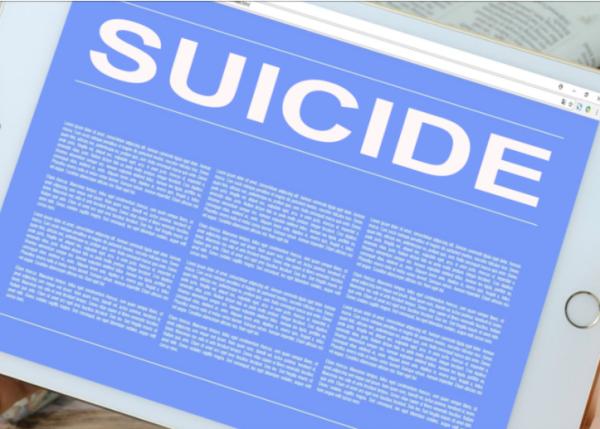A recent perspective piece in the Washington Post is a must-read for anyone who wants to understand the so-called "opioid epidemic." Authors Benjamin Cowan and Joshua Tibbitts wrote about the link between increased suicides in veterans impact and reduction of their prescription opioids. Finally! Someone gets it.
Can this article help reframe the thoroughly false narrative that prescription pills are killing tens of thousands of Americans every year? For the most part, the article is accurate. Nonetheless, there are a few statements that need to be examined.
As I and many others have been writing for years, what is being called the "opioid crisis" is now two separate crises: 1) a surge in overdose deaths (primarily caused by illicit fentanyl), and 2) the restriction of prescription painkillers, even to people with genuine medical needs. Our woefully misguided policies are based on the false hope that #2 will have any bearing on #1. It is now indisputable that this approach has been a dismal failure, something that ACSH advisor Dr. Jeffrey Singer and I made clear in our recent op-ed in the Philadelphia Inquirer.
Let's take a look at some of the key points from the article.
"It’s understandable that the Veterans Health Administration would be deeply concerned about opioid overdoses. From 1999 to 2019, almost 500,000 Americans died of such overdoses."
This statement is inherently misleading. By lumping legal prescription medications and street drugs like heroin and illicit fentanyl under the broad category "opioids" readers who are not intimately familiar with this issue will falsely assume that prescription pills primarily caused these deaths. More on this later.
"Treatment centers began to track veterans’ medication histories very closely, and doctors were strongly urged to try alternative pain-relief regimens... It had a dramatic effect on treatment: By 2020, the number of VA patients prescribed an opioid had fallen by 64 percent from the peak."
This reduction in prescribing also occurred for the general population, albeit to a lesser degree. Unfortunately, the "dramatic effect" was a train wreck that has ruined the lives of both veterans and other pain patients. In many cases, there are simply no viable alternatives to these powerful drugs.
"Recent research we conducted, however, suggests that the program may have had unintended negative effects. Looking at trends in violent deaths from 2013 to 2018, we found evidence in favor of this hypothesis: namely, a significant increase in veteran suicides after the implementation of the safety initiative." [Emphasis mine]
This speaks for itself.
"From 2010 to 2012, we did not see significant differences in the suicide trends of veterans relative to civilians... Starting in 2013, however, the first year of reduced opioid prescriptions caused by the OSI [Opioid Safety Initiative] (1), the rural veteran suicide rate rose markedly relative to other groups." [Emphasis mine]
Cause and effect? I vote yes. In case you're on the fence, the authors then point out that between 2013-18 the suicide rate of rural veterans rose by 75% compared to pre-OSI times (3). Think about it: a policy so misguided that it caused a huge increase in suicides in just five years. And this doesn't even take into account veterans whose lives have been ruined by pain and suffering and did not commit suicide – certainly a much larger number.
"[O]ther research has found that restrictions on prescription opioids appear to encourage use of more dangerous, illicit opioids; the use of illicit opioids, in turn, increases the risk of overdose."
I'll say. Otherwise, how can one explain Figure 1?

Figure 1. (Left) Opioid prescriptions have been radically reduced since 2011 (Source: Pain News Network), while at the same time (Right), total drug overdose deaths soared. Ignore that blip in 2018. By 2019 the number of deaths exceeded 2017. (Source: CDC).
It’s possible that the OSI discouraged [overdose] deaths even as it led to an increase in suicides but we view this as unlikely... [W]hile the introduction of opioids to new patients does increase their long-term risk of overdose, it is by an order of magnitude smaller than the suicide effects we identified after the introduction of the OSI. In short, the increased suicides we found were unlikely to have been offset by lives saved by other means as a result of the [OSI] program. [Emphasis mine]
Bingo. The OSI claims ten times the number of lives than it saves. And this figure does not even begin to address the number of people who suffer but did not commit suicide – a much larger number.
[O]ur estimates suggest that a sizable group of veterans, particularly those living in rural areas, have suffered as a result of a stricter opioid environment (after many years of relatively lax opioid policies).
What applies to veterans also applies to civilians who live with pain. A "stricter opioid environment" causes suffering and death, exactly the opposite of what it was (supposedly) designed to prevent. But don't just take their word for it. I have fielded hundreds of questions and comments from individuals suffering mightily from dreadful US opioid policies. Here are some of them. (Warning - some of these are deeply disturbing.)
Our findings suggest that policies that swiftly and significantly curtail opioid prescriptions should be approached with great caution.
If one can find any "humor" in the catastrophic crackdown on opioids it would be here. Great caution?? I'm speechless. This is exactly the opposite of what happened when the execrable Physicians for Responsible Opioid Prescribing (PROP) secretly fed its ignorant and biased recommendations to a clueless CDC resulting in the sadistic 2016 CDC Guideline for Prescribing Opioids for Chronic Pain. Of course, these "guidelines" became laws in 37 states, and incalculable damage has been done to millions of pain patients. As noted by the American Medical Association, the CDC Guidelines have done harm to “great numbers of patients.”
Finally, let's look at recent data on the contribution of drugs like Vicodin and Percocet to the death toll.

Figure 2. Overdose deaths (per 100,000) 2011-2019. The death rate for prescription opioids (red) was unchanged – 3.8 deaths per 100,000 people. During the same time, deaths from cocaine, methamphetamine, heroin, and illegal fentanyl all rose substantially. Source: CDC National Center for Health Statistics
Figure 2 is even more telling than Figure 1. Cowan and Tibbitts have shown convincingly that cutting opioid doses to veterans greatly increases suicides. But what about deaths across the entire population? Note that between 2011 and 2019, the period where opioid deprivation was metastasizing, the contribution of prescription opioids remained unchanged at 3.8 per 100,000 (red hatch line).
Bottom line
Evidence of the negative consequence of cutting opioid prescriptions to those who need them keeps trickling in. Cowan and Tibbitts, in quantifying opioid deprivation and suicides, have filled in an important piece of the puzzle.
NOTES:
(1) Opioid Safety Initiative - a term that probably has George Orwell spinning in his grave.
(2) The increase in suicides in urban veterans was a "less dramatic" 33%. Sounds pretty dramatic to me.




